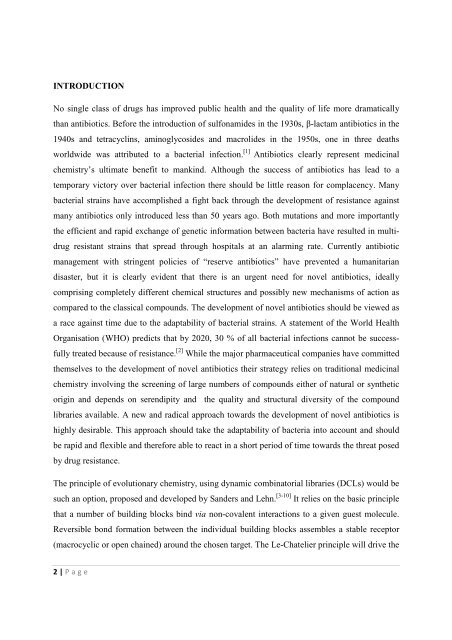The Development of Novel Antibiotics Using ... - Jacobs University
The Development of Novel Antibiotics Using ... - Jacobs University
The Development of Novel Antibiotics Using ... - Jacobs University
You also want an ePaper? Increase the reach of your titles
YUMPU automatically turns print PDFs into web optimized ePapers that Google loves.
INTRODUCTION<br />
No single class <strong>of</strong> drugs has improved public health and the quality <strong>of</strong> life more dramatically<br />
than antibiotics. Before the introduction <strong>of</strong> sulfonamides in the 1930s, β-lactam antibiotics in the<br />
1940s and tetracyclins, aminoglycosides and macrolides in the 1950s, one in three deaths<br />
worldwide was attributed to a bacterial infection. [1] <strong>Antibiotics</strong> clearly represent medicinal<br />
chemistry’s ultimate benefit to mankind. Although the success <strong>of</strong> antibiotics has lead to a<br />
temporary victory over bacterial infection there should be little reason for complacency. Many<br />
bacterial strains have accomplished a fight back through the development <strong>of</strong> resistance against<br />
many antibiotics only introduced less than 50 years ago. Both mutations and more importantly<br />
the efficient and rapid exchange <strong>of</strong> genetic information between bacteria have resulted in multidrug<br />
resistant strains that spread through hospitals at an alarming rate. Currently antibiotic<br />
management with stringent policies <strong>of</strong> “reserve antibiotics” have prevented a humanitarian<br />
disaster, but it is clearly evident that there is an urgent need for novel antibiotics, ideally<br />
comprising completely different chemical structures and possibly new mechanisms <strong>of</strong> action as<br />
compared to the classical compounds. <strong>The</strong> development <strong>of</strong> novel antibiotics should be viewed as<br />
a race against time due to the adaptability <strong>of</strong> bacterial strains. A statement <strong>of</strong> the World Health<br />
Organisation (WHO) predicts that by 2020, 30 % <strong>of</strong> all bacterial infections cannot be successfully<br />
treated because <strong>of</strong> resistance. [2] While the major pharmaceutical companies have committed<br />
themselves to the development <strong>of</strong> novel antibiotics their strategy relies on traditional medicinal<br />
chemistry involving the screening <strong>of</strong> large numbers <strong>of</strong> compounds either <strong>of</strong> natural or synthetic<br />
origin and depends on serendipity and the quality and structural diversity <strong>of</strong> the compound<br />
libraries available. A new and radical approach towards the development <strong>of</strong> novel antibiotics is<br />
highly desirable. This approach should take the adaptability <strong>of</strong> bacteria into account and should<br />
be rapid and flexible and therefore able to react in a short period <strong>of</strong> time towards the threat posed<br />
by drug resistance.<br />
<strong>The</strong> principle <strong>of</strong> evolutionary chemistry, using dynamic combinatorial libraries (DCLs) would be<br />
such an option, proposed and developed by Sanders and Lehn. [3-10] It relies on the basic principle<br />
that a number <strong>of</strong> building blocks bind via non-covalent interactions to a given guest molecule.<br />
Reversible bond formation between the individual building blocks assembles a stable receptor<br />
(macrocyclic or open chained) around the chosen target. <strong>The</strong> Le-Chatelier principle will drive the<br />
2 | P a g e

















